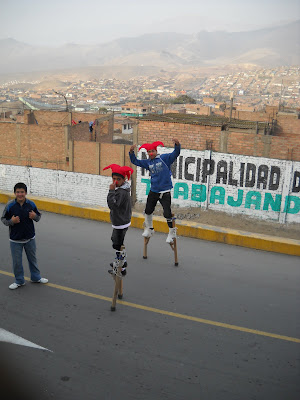
























On Sunday, my students from Jovenes de Buena Voluntad presented the show we've been working on for the past two months! JBV is a community-based organization run almost entirely by young people in Ventanilla, with help from one adult leader and a few volunteers from the area and abroad. The idea of the organization is that volunteers can suggest workshops, and the participants give feedback and then decide whether they want to participate. The young people also plan events and organize volunteer opportunities for themselves. It's a great model of grassroots organizing that emphasizes the importance of working in solidarity, and I've really loved working with them.
So: we staged TALENTO URBANO, a variety show that included improvisation, salsa, an original skit, juggling, and an awesome dance-off between break dancers and zanqueros (stilt walkers). The whole thing came together somewhat miraculously, considering that most of the actors missed our dress rehearsal (así es) and that we started about an hour late (par for the course). (A side note: a huge part of my learning curve has been relaxing my ideas of what it means to start "on time.") Nonetheless, the show was great-- the audience was really into it, and we had a full house by mid-show (people trickled in when they heard the music); the performers were energetic and funny and exciting to watch; and this was one of the first public events for JBV's new group in Villa los Reyes, so we got to share some of the work with the students' families and to spread the word about Jovenes de Buena Voluntad. On top of that, it was a lot fun, which was really the whole point in the first place.
Anyway, here are some pictures. Bravo to all of the performers!
*********
El domingo, ¡mis estudiantes de Jóvenes de Buena Voluntad realizaron el espectáculo en que hemos trabajando por dos meses! JBV es una organización de la comunidad que está guiado casi totalmente por jóvenes en Ventanilla, con el apoyo del un líder adulto y varios voluntarios locales y extranjeros. La idea de la organización es que los voluntarios sugieren talleres, y los participantes dan consejos y, de allí, deciden si quieren participar. Los jóvenes también planean eventos y organizan oportunidades para ellos mismos. Es un buen modelo de organizando de base que enfatiza lo importancia de trabajar en solidaridad, y me encantó la experiencia de trabajar con ellos.
Entonces: realizamos TALENTO URBANO, un espectáculo que incluyó improvisación, salsa, una escena original, malabares, y una competencia de baile entre bailadores de break y zanqueros. Todo se arregló por milagros, creo, considerando que la mayoría de los actores les faltó nuestro último ensayo (así es) y que empezamos más o menos una hora tarde (normal). (Una nota: un gran parte de mi aprendizaje ha sido un relajamiento de mis ideas de que significa “empezar a tiempo.”) A pesar de todo, el espectáculo fue bacán: los espectadores se lo gustó, y el espacio estaba llena después de un tiempo (la gente entró poco a poco que escuchó la música); los actores fueron energéticos y graciosos, y fue emocionante a mirarlos; y eso fue uno de los primeros eventos públicos del nuevo grupo de JBV en Villa los Reyes, y entonces pudimos compartir el trabajo con las familias de los estudiantes y también pasar la voz sobre Jóvenes de Buena Voluntad. Al fin, fue muy divertido, lo que fue la meta al comienzo.
Aquí va algunas fotos. ¡Bravo a todos los actores!

Franco, Ali, y GianMarco




 2. I'm applying to grad school. It's not as easy as it looks.
2. I'm applying to grad school. It's not as easy as it looks. 






